Partner of Research and Science
At the beginning of the 1990s InfraTec emerged as a spin-off from the Technische Universität Dresden environment. The proximity to science and research is something we were born with. Dresden, the city of our headquarters, is considered one of the most important technical university locations in Germany. Numerous universities and research institutions are located in the region. With this background InfraTec has been participating in research projects for many years.

As one of the world's leading specialists in infrared thermography, our expertise lies primarily in the extensive knowledge of a technology that is still relatively new compared to others. As part of each individual project, we gain new experience in order to pave the way for thermography into previously unexplored fields of application.
Our partners are both national and international scientific institutions and companies from a wide range of industries. A selection of the projects that have been successfully completed or are currently running with these partners will give you an insight into our activities in this field.
InfraTec Company Memberships
The company InfraTec is a member of some associations and societies to report there about the topics infrared sensor technology and thermography, to be available as a contact person and to exchange with others.
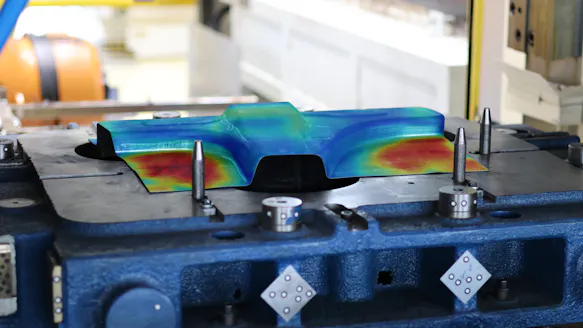
Thermal Imaging and AI Provide Reliable Quality Predictions in Hot Forming
Various hot forming processes (forging, press hardening, deep drawing, etc.) are used in industrial production. Quality control in hot forming can be challenging: typically, the workpiece needs to be cooled down before analysis. Conventional optical quality assurance methods are of only limited use for hot components, as the accuracy of geometric measurements decreases with rising workpiece temperatures. Within the GreenHiTemp project, it was demonstrated that thermography combined with artificial intelligence enables reliable predictions during press hardening in ongoing production, thus allowing for early corrections.
Press hardening combines the benefits of heat treatment and forming. It enables the production of high-strength yet particularly lightweight car body parts, such as B-pillars in automobiles. Process-related quality defects lead to high reject rates and, consequently, unnecessary costs. With GreenHiTemp, the Fraunhofer Institute for Machine Tools and Forming Technology IWU and InfraTec GmbH pursued a different approach. The aim of the project, supported by the Federal Ministry for the Environment, Nature Conservation, Nuclear Safety and Consumer Protection (BMUV), was to optimize the use of thermography for quality assurance in press hardening. The results showed that the temperatures of the workpieces, as determined in thermal images, allow reliable conclusions to be drawn about their quality. By using an appropriately trained machine learning model, it is possible to predict the hardness of the component.
Production employees can use a simple color scheme to identify areas of the component that are outside the permissible specifications. At the end of the forming process, the entire component can thus be easily classified as “OK” or “defective”. This early transparency allows trends to be identified and, in the event of defects, enables timely intervention in the process.
The benefits of AI-supported thermographic analysis are compelling. Instead of random sample checks, the entire batch can be inspected during the ongoing process. This non-destructive testing method eliminates time-consuming and labor-intensive failure analyses. Early defect detection reduces the number of scrap parts and thus significantly lowers costs. The testing method developed in the GreenHiTemp project ensures a significantly more resource-efficient and effective production process.

Assessment of rotor blades on wind turbines using passive thermography
Wind turbine rotor blades are subject to very high stresses if they are in constant operation for many years. They are exposed to influences such as weather, lightning strikes and, in the case of offshore installations, salt water. If cracks, erosion damage or internal structural changes occur in the rotor blades because of these influences or hidden production defects, this can lead to the failure of the turbine and, in the worst case, to personal injury. For this reason, the rotor blades must be regularly inspected and maintained.
The aim of the EvalTherm joint project, funded by the German Federal Ministry for Economic Affairs and Energy (BMW K), was to develop, evaluate and establish an optimized procedure for monitoring the condition of wind turbine rotor blades from the ground or by means of a drone. This should enable the early detection of possible blade failure and the initiation of preventive maintenance.
The research project was based on a testing method introduced by the Fraunhofer Institute for Wood Research, Wilhelm-Klauditz-Institut (WKI), which uses heat flow or active thermography. In this process, the distribution of temperature on the surface of the rotor blade is detected after thermal excitation. To get a more cost-effective and reliable procedure, it was adapted by the German undesanstalt für Materialforschung und -prüfung (BAM) so that solar radiation, wind or the natural temperature curve over the course of the day can be used as a “passive” form of excitation.
As part of the EvalTherm project, InfraTec developed a drone-compatible thermographic camera with a cooled detector and a high thermal resolution. This allows the recording of the surface temperature on the rotor blades from the air, which significantly reduces the effort required for data collection. From the spatial and temporal temperature gradients information about hidden damage or changes to the structural mechanics can be derived. To make reliable statements, all external environmental conditions that could influence the temperature had to be considered.
A method patented by BAM, the differential measurement on three rotor blades, was used to compare the temperature distribution. With this method, the temperature distribution can be measured simultaneously on all three rotating rotor blades of the wind turbine and the values can then be compared with each other. Any differences that occur are an indicator of possible damage and enable timely intervention.
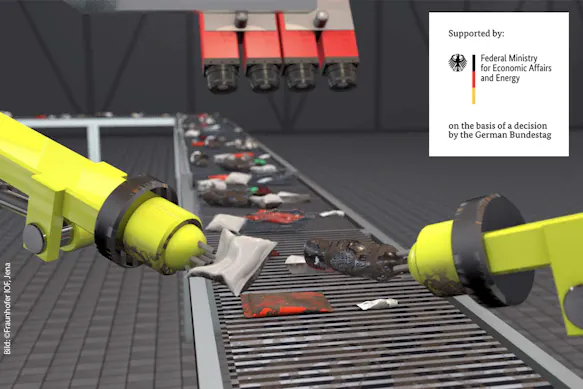
Camera Technology to Facilitate the Use of Multimodal Imaging in Circular Economy and Healthcare
RUBIN-AMI (“Advanced Multimodal Imaging”) is an alliance of companies and research institutes, concentrated mainly in Thuringia, Germany, whose work is dedicated to the development of multimodal imaging techniques across multiple spectral ranges (VIS, SWIR, MWIR, LWIR).
The partners involved in the alliance are developing standalone modules such as image recording units with special functions (e.g., multispectral, 3D) as well as lighting units which will then be combined to form multimodal imaging systems that use methods of multimodal sensor fusion and integration.
Due to its extensive experience with thermography camera technology across a range of performance classes in the MWIR, LWIR, SWIR, and NIR spectral ranges, InfraTec will be focusing on combined multispectral image capture in the MWIR and SWIR ranges in this project.
It is hoped that, in the future, the systems containing the components and algorithms developed in this context will be capable of performing tasks in the circular economy; for example, capturing and classifying objects in material mixtures and separating them out into different materials prior to further processing. Specific products that the RUBIN project plans to develop include a recognition module for identifying plastic containers so they can be sorted by material type as part of a return system, and a device for automatically analyzing the composition of construction waste recyclates.
Other systems are set to be used in the growing healthcare sector; for example, in the form of a contactless vital and activity sensor.
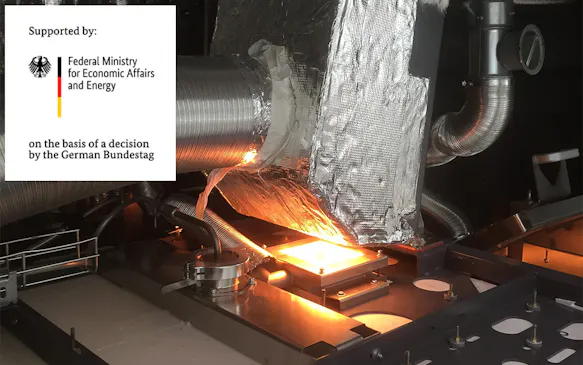
Process Development and Control of Contact Firing Processes for High-efficiency Silicon Solar Cells
The Research Project “FEUERDRACHE”
The target of the research project under the management of the Fraunhofer Institute for Solar Energy Systems ISE Freiburg, was the optimisation of the production process for high-efficiency PERC silicon solar cells. For this purpose, an innovative contact firing process together with the associated in-situ process control was to be achieved. In the sub-project of InfraTec, a technology for contactless measurement and monitoring of the wafer temperature in the contacting process was developed to achieve this purpose as an alternative to the previous temperature measurement with thermocouples.
In the project, different thermographic systems were integrated in the contact firing furnace. These were adapted and successfully tested by the use of conventional and innovative beam sources (IR emitters and VCSEL diodes) according to the specific requirements in terms of wavelengths, power densities, high ambient temperature as well as to the different spatial scenarios. The infrared camera ImageIR® 8300 delivered excellent results in the specific application.
Instead of the punctual measurement of the process temperature in the furnace and extensive individual measurements on specially prepared cells, the results of the research project showed that the complete recording of the temperature distribution of the entire wafer surface is possible. Hereby, the process temperature in the "peak zone" can be optimally controlled, the throughput speed increased, and the production costs were reduced as well as simultaneously higher cell efficiency can be achieved.
The research project „Feuerdrache“ was supervised during the period from 01.07.2017 until 30.06.2020 by the project sponsor Jülich (PTJ) under the promotional code 0324205B. The financing of the project was supported on the basis of a resolution of the German Parliament by the Federal Ministry of Economics and Energy.
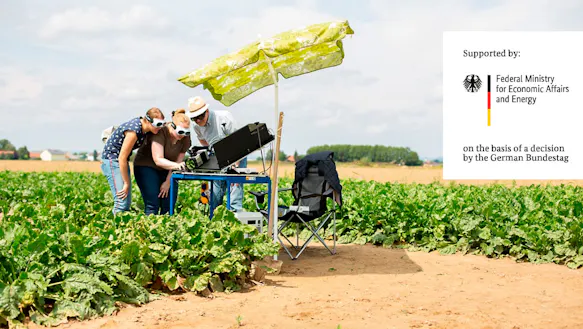
A Successful Cooperation against Plant Diseases
Data Fusion in Plant Phenotyping for Cercospora Detection in Sugarbeets
Various sensor technologies had been evaluated regarding their usability for the detection of the plant disease Cercospora in the joint project „Data Fusion in Plant Phenotyping for Cercospora Detection in Sugarbeets“ (DataPlant), funded by the German Ministry of Food and Agriculture. The sensor data acquired by georeferenced LIFT and hyperspectral systems, drone based RGB cameras and weather stations were processed and combined – among themselves as well as with traditional scoring methods - using sophisticated Big Data algorithms. Besides the already established RGB images, the determination of vegetation index values by hyperspectral measurements seems to be a promising sensor-based detection method.
The project partners Clausthal University of Technology, KWS SAAT SE & Co. KGaA, MG Optical Solutions GmbH and InfraTec GmbH Infrarotsensorik und Messtechnik developed an innovative sensor system, which shall detect a Cercospora infection by laser induced IR spectroscopy. The plant leaves are irradiated by a quantum cascade laser at wavelengths of typical absorption bands of Cercospora related molecules whereon the resulting surface temperature changes are detected by a radiometrically calibrated thermal camera VarioCAM® HD head by InfraTec.
So, the project „DataPlant“ demonstrated various sensor technologies which are potentially suited for an automated detection of plant diseases and could provide data for digital system solutions in plant production and breeding in future.
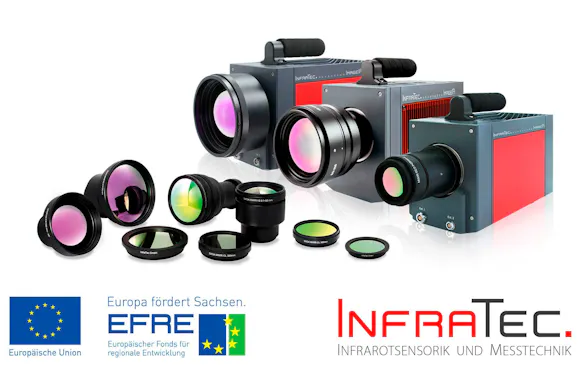
Quality Inspection and Production Monitoring of Ceramic Precision Components
The Ceremony Research Project
Using regenerative energy forms comprehensively at all times, both industrially and privately – this idea currently fails because, among other reasons, the right technologies for mass energy storage are not available on the market. High-temperature batteries based on sodium nickel chloride are among the solutions to which researchers worldwide ascribe the potential to provide a remedy in future. Tubes made of beta-alumina serve as electrolyte membranes in these special batteries. But their production is technologically far from maturity. For example, efficiency currently suffers because the quality inspection takes place laboriously by hand.
An automatable, non-destructive inspection based on infrared thermography could reduce the risks of subjective influences on the inspection results drastically and increase reliability during production. In the Ceremony project, InfraTec, together with four other German partners and with financial support from the European Regional Development Fund of the European Union, is searching for suitable ways to inspect such ceramic precision components efficiently and in a way suitable for serial production.
Operation temperatures inside the cell of a sodium-nickel-chloride battery are typically around 300 °C. While their housing consists of several walls and is vacuum-insulated – still, even the smallest errors in the beta-aluminate cups can cause great damage. With active thermography, even very thin cracks and delamination can be detected in many cases. Use of the high-end infrared camera series ImageIR® from InfraTec fulfils important requirements for development of an inspection system with ultrasound excitation. If its suitability for this application is proven, its area of application should be expanded in future to include inspection of additional ceramic parts in machine building, medical technology, electronics and analysis technology, for example.
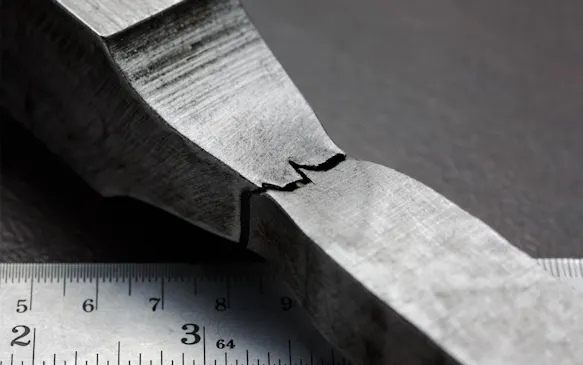
Crack Detection in Steel Production
The AMPLAST Research Project
The project AMPLAST focused on innovative process monitoring with the goal of implementing quantitative, fast and non-destructive laser thermography for in-line production monitoring in steel production. Four cooperation partners from Germany and India participated in the project. InfraTec worked mainly on detecting surface and near surface cracks.
The ImageIR® 8300 hp infrared camera was used to solve these inspection problems. One of the tasks was to implement the computationally intensive data-processing processes necessary to use a infrared camera on a FPGA inside the camera. That reduces the processor workload of the computer equipment connected to the infrarec camera considerably and represents a noticeable gain for inline crack detection in industrial steel production. Additionally, InfraTec created a software program that combines online image recording from the infrared camera with algorithms for crack detection.
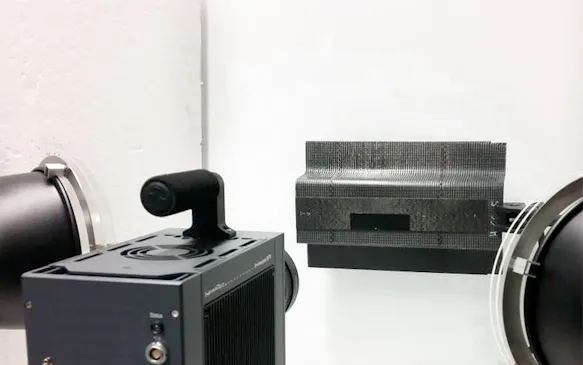
Inspection of CFRP Compounds and Components
The GEWOL Research Project
Fibre-reinforced plastics, such as CFRP and GRP, offer numerous advantages for lightweight design of aircraft and automobiles. But the economic, flexible and automated production of these materials in large volumes has been delayed by the lack of suitable processing, inspection and measurement procedures. Laser technology promises help here. InfraTec worked together with Audi and six additional partners from science and industry to optimise the possibilities to use local laser energy application, customised for the respective production requirements, for processing temperature-sensitive materials.
In the GEWOL project, InfraTec participated concretely on further development of laser-excited thermography. This can be used to inspect the adhesive joints of CFRP and GRP components. The same applies for compounds of plastic materials with steel or aluminium. Until now, this has typically been done using ultrasonic procedures or classical flash thermography.
Laser-excited thermography proved to be a very effective method of component inspection. The excitation intensity was distributed far more homogeneously. At the same time, excitation could be applied onto a larger surface, which saved valuable time in every inspection procedure. In addition to area excitation, this procedure easily permitted linear excitation, which provided additional advantages when working with varying geometries of inspection objects. Due to its detector format of (1,920 × 1,536) IR pixels, the infrared camera developed in the project, ImageIR® 10300, is able to capture the smallest geometrical details.
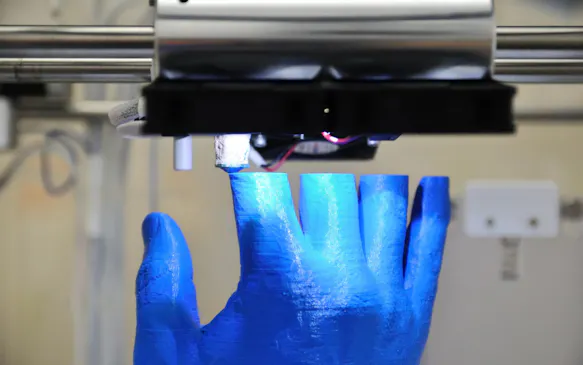
More Efficiency in Laser Sintering with Plastics
The HiPer-LS Research Project
Increasing the productivity and reproducibility of laser sintering with plastics through new technological solutions – this was the goal of the HiPer-LS project, in which a total of eight partners from Germany worked together.
Laser sintering is a tool-free technology, which enables to produce three-dimensional workpieces in very complex shapes. Thermal process guidance with a high-resolution infrared camera plays a large role in further increasing efficiency and lowering costs while achieving the same or higher quality.
A VarioCAM® HD head 900 from InfraTec was used to monitor the production process. The thermographic measurements it made formed the basis for optimising the temperatures of the melted mass and the powder bed as well as the energy application by the laser. The goal was to achieve a melting temperature that was as homogeneous as possible and stable for a long time. When this is successfully achieved, the result is a correspondingly homogeneous melt film. The components made with this procedure are denser, have fewer pores and show more homogeneous shrinkage.
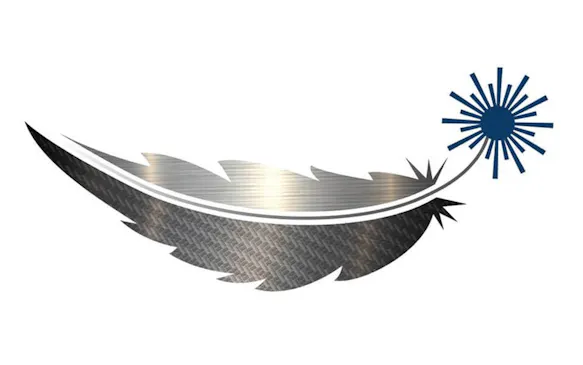
Thermographic Process and Quality Monitoring for Dissimilar Lightweight Designs
The LaserLeichter Research Project
Modern automobility and lightweight construction are inseparable today. In addition to energy savings, vehicles must continue to achieve a high degree of safety, so lightweight materials are combined with high-strength materials. This requires the development of new production and inspection procedures. The LaserLeichter project combined more than ten partners from science and industry from throughout Germany, who devoted themselves to this goal.
The focus of interest included composites of metal and fibre-reinforced material. Thermographic process monitoring can reveal weak points when these composites are joined. In addition, missing bonds in the joint location can be detected through non-destructive inspection of the composites using the ImageIR® series infrared camera from InfraTec, which was used in the project.
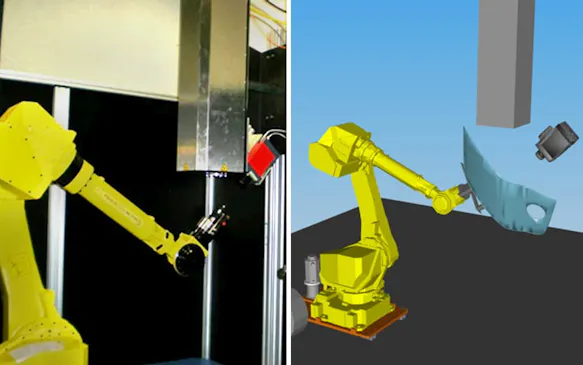
Automated Crack Detection on Forging Parts
The ThermoBot2 Research Project
Manufacturers and processors of forgings have inspected workpieces for undesired cracks using magnetic particle inspection for decades. This inspection method only provides subjective results, is time consuming, hard to automate and ecologically problematic due to the chemicals used. The robot-based, laser-induced active thermography offers an attractive alternative. As part of the ThermoBot2 project of the Austrian Research Promotion Agency (FFG), InfraTec worked together with four Austrian partners to further develop this modern alternative solution for industrial production. The idea is to heat forgings locally with a laser and observe the heat propagation with the ImageIR® 8300 infrared camera. Resulting temperature differences are shown on the high-resolution thermograms, from which possible cracks can be detected and localised through complex evaluation procedures.
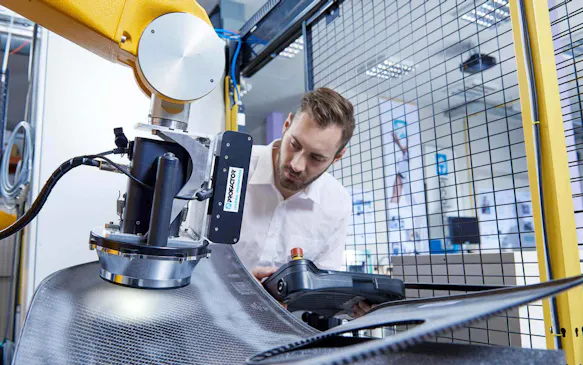
The ImageIR® 8300 hp in Use for Research Applications
The SPIRIT Research Project
InfraTec expands its know-how in the field of thermography by participating in various research projects. The ImageIR® 8300 hp is used, for example, in the SPIRIT project. A total of eight partners from Austria, Italy and Germany are working together to simplify the use of inspection robots for quality control of complex shaped parts. Up to now, robots for solving such tasks have been programmed specifically for each application. This is usually very time-consuming and causes high costs. In future, in contrast, a simple set-up will be sufficient for the robot-supported testing task.
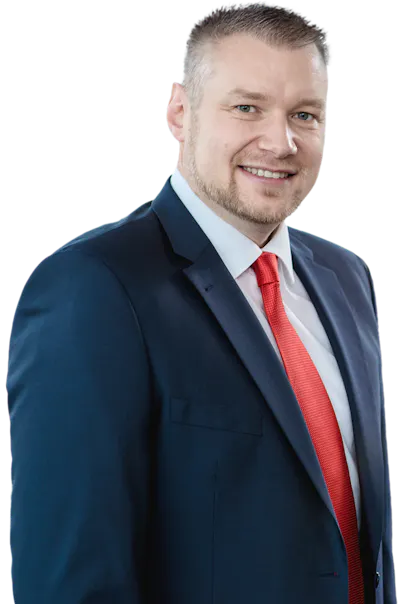
Would You Like to Know More?
It is not unusual for tasks to be associated with special requirements. Discuss your specific application needs with our specialists, receive further technical information or learn more about our additional services.